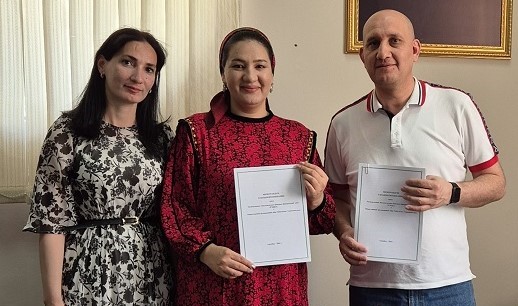Semi-deserts and deserts occupy almost 4/5 of the territory of Uzbekistan out of 447.7 thousand km². According to Uzhydromet, the average annual temperature in the country increased by 1.6°C, which exceeds the average temperature increase in the world. Forecasts predict temperature rise by another 1.5-3°C by 2030-2050, especially in the Aral Sea region. Climate warming impacts the decrease of rivers and the increase of evaporation. Experts note that climate change will inevitably lead to increased water shortages under the current situation in irrigated agriculture in Uzbekistan.
The project “Climate Adaptation and Mitigation Program for Aral Sea Basin” (CAMP4ASB) of the Regional Environmental Centre for Central Asia (CAREC) helps farmers in Uzbekistan adapt to climate change. Its support includes developing and implementing new technologies, training farmers to use resources sustainably, improving water management and developing climate change adaptation strategies.
The CAMP4ASB project is implemented by CAREC together with EC IFAS with the financial support of the World Bank. In 2020, CAREC received additional funding from the Green Climate Fund (GCF) to continue the work started in 2015 to provide climate investments in Tajikistan and Uzbekistan within the framework of the Climate Adaptation and Mitigation Programme for the Aral Sea Basin Additional Financing (CAMP4ASB AF).
The projects took into account the climatic features of the country and aimed at organizing greenhouse farms equipped with a modern climate control system, an automatic drip irrigation system with soil moisture control, electric pumps for groundwater, solar panels, shading and plant hanging systems.
Karakalpakstan: how to get high yields on salt marshes
The Kungrad district of the Karakalpak Republic of Uzbekistan lies next to the Aral Sea, the Amu Darya and the Ustyurt Plateau and belongs to an environmental disaster zone due to the drying up of the Aral Sea. Today, in its place is a salt marsh desert with several small remnants of a once-living, abundant sea.
Farmers in the Kungrad region faced shortages of irrigation water and power outages.
“Our agricultural production suffered greatly without water and electricity. Every year the farmers increasingly struggled for irrigated water,” says Jamshid Makhmudov.
But the farmers’ love for the land, hard work nurtured over centuries, the CAMP4ASB project support, and most importantly, the ability for cooperation, helped overcome these harsh consequences of the climate drama and made it possible to achieve success.
The production cooperative “Makhmudov Zhamshid” united 30 founders and 110 family members who cultivated 25 hectares of agricultural land in the Kungrad region of Karakalpakstan.
The CAMP4ASB project helped them solve the problem with water and electricity. They drilled three 30-meter wells and installed deep-well pumps with a capacity of 3 kWh for each. They established a drip irrigation system and a 7 kW/hour pump to distribute evenly water over 25 hectares of fields. They built a settling pool covered with a geomembrane to accumulate water and remove impurities from it. As a result, farmers always have clean water without technical losses due to filtration.
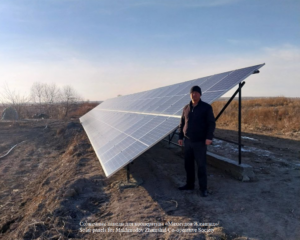
Besides, the farmers solved electricity problems by installing solar panels with a capacity of 22 kWh. As a result, all water pumps work efficiently and without interruption.
“We now have a reliable source of water and electricity. Frequent and severe droughts are no longer a problem. Even under these conditions, we get good yields. In addition, our energy costs have decreased,” says Jamshid Makhmudov.
The experience of the production cooperative “Makhmudov Zhamshid” shows that even in the harshest conditions, renewable energy sources and a drip irrigation system help to survive and achieve success.
How green investments turned waste into income
Residents of Urgench constantly complained about the Real Loman Parranda poultry farm. And all because of the unpleasant, pungent odour emitted by one of its waste products – bird droppings. It is known that bird droppings are one of the hazardous wastes that pollute the soil, reservoirs, and groundwater and serve as a source of parasitic diseases.
In addition, the temperature inside poultry farms is always elevated due to the large number of poultry, whose average body temperature varies from 40 to 42°C. To keep chickens healthy, you should maintain a comfortable temperature for them all the time. And this requires high energy costs.
The owner of the Real Loman Parranda poultry farm, Zafarbek Matnazarov, solved these problems thanks to green investment under the CAMP4ASB project.
He introduced a system for processing poultry manure, automated the supply of water and feed, and increased the energy efficiency of production through modern technologies and equipment for the factory’s cooling system. On the hottest days, the factory uses only 18 kW of electricity, and it halves on cool days.
“We have not only reduced production costs but also improved air quality. Now no one complains,” says Zafarbek Matnazarov.
Owing to the new system for arranging and cleaning cages, liquid bird droppings are dried and served organic fertilizer. The factory produces 50 tons of poultry manure per year.
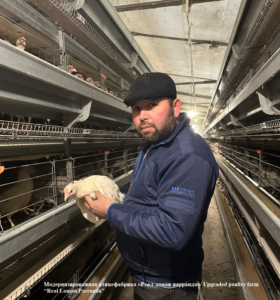
Modernization of the factory with the use of renewable energy sources turned out to be so economically profitable that Zafarbek Matnazarov intends to build a second poultry farm for small chickens at his own expense.
The history of the Real Loman Parranda poultry farm demonstrates that “green” technologies are much more profitable and environmentally friendly than traditional ones.
How it rains on rainfed lands according to schedule
“We lost up to 80% of our harvest,” recalls Azim Akhmedov, director of the Ulugbek Tarakiyoti production cooperative. – Our land is located in rainfed lands. It means that the lands lie in areas inconvenient for irrigation, and the only source of moisture is moisture in the soil and rains in the spring. We depended on rainfall, which sometimes was not there at all or not enough.”
The production cooperative “Ulugbek Tarakiyoti” unites 22 founders and 85 family members cultivating 40 hectares of agricultural land in the Navbakhor district of the Navoi region.
The climate of the Navoi region is sharply continental and desert with frequent droughts. Rainfed farming in such conditions increases farmers’ dependence on natural precipitation and causes the risk of crop loss.
“We spent much time and energy looking for alternative irrigation methods, but they were all ineffective. When we received a grant from the CAMP4ASB project to install a sprinkler system, it was a real advance for us. We were no longer dependent on changeable weather,” says Azim Akhmedov.
Thanks to the CAMP4ASB project, farmers of “Ulugbek Tarakiyoti” installed a sprinkler irrigation system, drilled a well for it with a deep pump, and built a pool to collect and store water for irrigation during droughts.
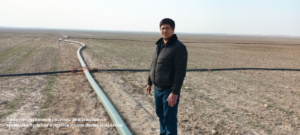
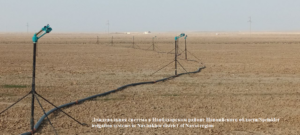
Here is how the story of “Ulugbek Tarakiyoti” shows how adaptation technologies in the context of climate change bear abundant fruit and lead to prosperity.
Additional information:
Dilovarsho Dustzoda – Climate Change and Sustainable Energy Program Manager/Project Coordinator CAMP4ASB AF, recath_manager@carececo.org



